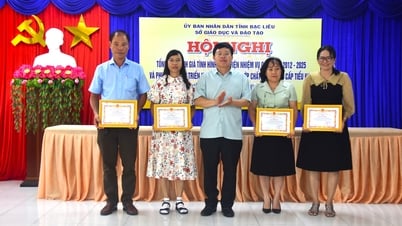In recent months, the rice market in the Mekong Delta has fluctuated a lot, with the price of summer-autumn and autumn-winter rice in 2023 considered the highest ever. Exports have shown many positive signs, but to be sustainable, industry experts suggest that many solutions are needed.

Reduce loss, improve quality to increase profits for rice growers.
Rice exports increase in volume and value
According to estimates by the Ministry of Industry and Trade, rice exports in October 2023 reached 700,000 tons, equivalent to 433 million USD, unchanged in volume and up 27% in value compared to October 2022. It is estimated that in the first 10 months of 2023, Vietnam exported about 7.1 million tons of rice, worth nearly 4 billion USD, up 17% in volume and 35% in value compared to the same period in 2022.
According to the Vietnam Food Association (VFA), as of November 1, compared to the group of major rice exporting countries in the world, Vietnamese rice is having the highest price. Specifically, Vietnam's 5% broken rice is priced at 653 USD/ton, Thailand's is priced at 560 USD/ton and Pakistan's is priced at 563 USD/ton. Vietnam's 25% broken rice is traded at 638 USD/ton, Thailand's is priced at 520 USD/ton and Pakistan's is priced at 488 USD/ton.
The rice market is experiencing many fluctuations and the price of this commodity has been on an upward trend for a long time. The high price of rice is often due to the impact of parties in the supply chain, leading to difficulties in delivering goods for businesses, because export contracts have a delivery time of at least 1 to 3 months.
According to Mr. Do Ha Nam, Vice President of the Vietnam Food Association (VFA), in the current situation of Vietnam's rice prices increasing rapidly, some businesses have suffered too much loss and canceled contracts, especially for businesses with weak economic capacity. In cases where large businesses are almost finished delivering goods, in order to keep their reputation with partners, they are forced to buy at high prices to collect enough goods to fulfill the contract. This is the main reason for the high price of rice.
“The sharp increase in rice prices is also due to the influence of suppliers. Every time the price of rice increases a little, they contribute to pushing the price up further, and as a result, the price of Vietnamese rice is at a record high. It should be added that Vietnamese businesses are used to signing long-term contracts, so now most of them are concerned with buying rice to deliver to their partners,” said Mr. Do Ha Nam, Vice President of VFA.
According to VFA, “the price of Vietnamese rice increasing too high is not necessarily an advantage”, because when the price is high, customers will look for other markets with better prices and rice quality equivalent to Vietnamese rice, especially Thailand, leading to the risk of losing the fragrant rice market (DT8, OM 5451...) to Thai businesses (previously, Vietnamese fragrant rice had very competitive prices, so it gradually took over many markets from Thai businesses), because the price of rice in this country is very competitive compared to the price of Vietnamese fragrant rice.
Specifically, in the bidding packages of the Indonesian National Logistics Agency (Bulog), Vietnamese enterprises almost never win bids because domestic rice prices are very high and the type of rice Bulog calls for bidding, 5% rice, is often scarce.
Forecasting the rice export market in 2024, Mr. Pham Quang Dieu, Chief Economist of AgroMonotor Company - a market research company, said that Vietnam's rice exports this year are likely to reach 8 million tons, so in 2024 the inventory will be very thin, so businesses must be very careful, otherwise it will be very risky like this year, signing many contracts but not anticipating the limited supply, then the price will rise and face difficulties. On the other hand, it is also necessary to note that India may return to the market, the rice price level will be lowered, currently the price of Vietnamese rice is too high, the price of rice is high but Vietnamese rice is almost unsold, this is also a limitation that reduces the competitiveness of Vietnamese rice compared to other rice exporting countries. In order for businesses to be able to do better export business in 2024, businesses must be extremely careful in deciding to sign long-term contracts, because of limited supply, combined with difficult credit capital. If banks can promote credit for the rice industry, it will then support businesses better in export business activities.
“Vietnamese enterprises often sign long-term contracts with delivery times ranging from 1 to 3 months (depending on the contract). Signing long-term contracts is also a high risk, because the problem of Vietnamese enterprises is lack of capital, so they cannot have a guaranteed amount of inventory, because often after signing the contract, the enterprise only starts purchasing, which has many risks. Compared to Thai enterprises, their access to credit sources is much more favorable than Vietnamese enterprises, and credit capital is one of the weaknesses of Vietnamese rice enterprises,” said Mr. Dieu.

Rice exports flourish, rice prices increase, farmers are more excited.
Need to reduce loss and improve rice quality
The climate conditions in the Mekong Delta are very favorable for bumper rice crops, but recently climate change has also caused many difficulties for rice production in the region and affected the quality of rice.
According to statistics from the United Nations, agricultural production in Vietnam suffers from losses of 14-35%, of which the rice industry loses about 14%/year. Post-harvest losses occur at all stages, but the drying stage is the highest, although the number of dryers has met 80-90% of the demand, but because most of the drying kilns in Vietnam are not automated and depend on the skills of the operator. If the operator is not skilled, the high temperature and drying speed will cause the rice grains to crack, ... greatly affecting the profits of the enterprise.
According to technology experts, to keep the quality of rice grains fresh, delicious and without losing quality from harvest to consumers, there is no solution other than applying technology, because in reality, the factors that contribute to increasing the income of farmers and businesses in the rice chain do not have much room left.
Therefore, in order to increase the value of agricultural products and increase profits for all parties in this industry chain, it is necessary to apply technology to reduce losses not only in quantity but also in the quality of rice grains, reduce the use of electricity in the milling process, and reduce electricity costs to increase profits. This is a solution that many businesses are interested in investing in.
Mr. Cao Thanh Dat, Business Manager of Buhler Vietnam Rice Processing Solutions, said that the rice market has undergone many fluctuations, especially for the rice export market. Although the volume and value of rice exports have increased compared to previous years, the cost of input materials has also increased along with competitive pressure in the market, forcing rice export suppliers and exporters to be extremely careful in their production activities to ensure profits.
Therefore, one of the decisive factors for the efficiency and cost of the producer is to reduce rice loss and optimize costs in the rice processing process. With solutions such as rubber rollers for long-lasting peeling, reducing breakage, SmartWhite whitening machine to reduce rice breakage, reduce production costs, save energy... can help processing plants reduce loss and optimize production costs.
According to Mr. Jens Vinther Jensen, CEO of FFT, using modern technology will help reduce rice quality loss such as using modern drying technology and storing in warehouses with controlled environments, long-term storage systems will still maintain the best quality of rice. Besides, Vietnamese and world consumers are currently concerned about food safety, so controlling the entire production chain from field to table according to standards and good agricultural practices is very necessary and applying artificial technology to control the rice production process is a solution of interest today...
Article and photos: HOAI THU
Source




![[Photo] Prime Minister Pham Minh Chinh chairs conference on anti-smuggling, trade fraud, and counterfeit goods](https://vphoto.vietnam.vn/thumb/1200x675/vietnam/resource/IMAGE/2025/5/14/6cd67667e99e4248b7d4f587fd21e37c)
























































































Comment (0)